RIMINI & SURROUNDINGS: ATTRACTIONS AND HIGHLIGHTS
The millenary city.
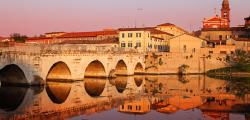
TIBERIUS BRIDGE
Tiberius Bridge, that was realized almost 2000 years ago, bears witness to the ancient Roman ability in building. The bridge, that was mostly made from Istrian stone, was commissioned by Augustus in 14 A.D. and finished by Tiberius in 21 A.D.. This imposing structure, that once marked the beginning of the Via Aemilia, has survived the vicissitudes of war and is still perfectly preserved.
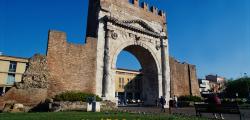
ARCH OF AUGUSTUS
The Arch of Augustus was commissioned by the Roman Emperor Augustus in 27 B.C. It is the oldest existing Roman arch in the world. This 17-metre-high structure, that was mostly made from Istrian stone, boasts a sober and austere style. The four clypeuses that embellish the capitals depict four Roman Gods: Jupiter and Apollo face Rome, while Neptune and Roma face the city.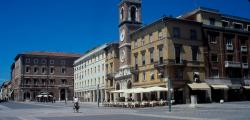
PIAZZA TRE MARTIRI
This charming square, the ancient Roman Forum where the Roman Decumanus Maximus and Cardo met, is dominated by the statue of Julius Caesar. The nearby Via IV Novembre is home to a commemorative stone bearing the words Caesar told his troops after the crossing of the river Rubicon. This square, that was originally called Piazza Giulio Cesare, was then renamed Piazza Tre Martiri to celebrate three partisans who died here in 1944: Mario Cappelli, Luigi Nicolò and Adelio Pagliarani.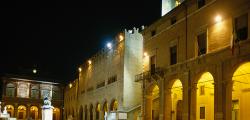
PIAZZA CAVOUR
While Piazza Tre Martiri bears witness to the splendour of the Roman Empire, Piazza Cavour is the most important medieval square of the city. It is dominated by sumptuous palaces and buildings, such as Palazzo dell’Arengo (1204), that was once the seat of the local authorities, and Palazzo Podestà (1330). Not to be missed are further prestigious monuments dating back to a subsequent period, such as the Statue of Pope Paul V (1614), that was erected during the papal domination, and the famous Pigna Fountain - Cone Fountain (that was built in the Roman Age and subsequenly remodelled in 1543), that is embellished by 15 beautiful taps.
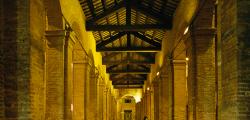
VECCHIA PESCHERIA
The city's eighteenth-century ancient fish market develops next to the central Piazza Cavour. With its large stones, fountains and big clock, it is one of Rimini's most representative landmarks. Today, the narrow streets that develop around the Pescheria are scattered with street bars, fine restaurants and the trendiest clubs of the city. The famous Rimini's “movida” revolves around this fascinating area.

MALATESTA TEMPLE
Malatesta Temple, or Cathedral of Santa Colomba, is Rimini's most important church. This imposing structure, whose renovation was commissioned by Sigismondo Pandolfo Malatesta and carried out by illustrious artists, such as Leon Battista Alberti, Matteo de' Pasti, Agostino di Duccio and Piero della Francesca, is the most important Renaissance building in Rimini and one of the most representative fifteenth-century architectural complexes in Italy.
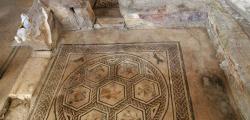
DOMUS DEL CHIRURGO
The Domus del Chirurgo - House of the Surgeon (second half of the II century A.D.) is a perfectly preserved Roman house that belonged to a surgeon. The house, that has only recently been discovered (1989), has become an important resource for Rimini tourism since 2007. It contains an extraordinary collection of ancient surgical instruments, such as pliers, scalpels, lancets and tubes, as well as bronze scales and measuring cups, terracotta vases, phials and plenty of further containers.
Villages and Castles

SAN LEO
The picturesque village of San Leo and its imposing fortress rise on the top of an impressive rock spur that gazes across Valmarecchia from on high, and can only be reached through a scenic route that develops on the slopes of Mount Feliciano. The city centre cherishes outstanding monuments and art treasures of great value. The imposing XV-century fortress is the city's most representative landmark. During the years of the Papal domination, it became famous as the prison of Count Cagliostro and Felice Orsini. Other places worthy of mention in the lovely medieval village are the well-preserved pre-Romanesque parish church and the XII-century Lombard-Romanesque Duomo.
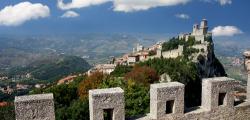
REPUBLIC OF SAN MARINO
San Marino, that was founded in 301 A.D., is the oldest republic in the world. Its peculiar geological conformation, ancient history and genuine traditions make it unique and incomparable, and even contributed to its inclusion in the prestigious list of UNESCO World Heritage Sites. The three towers that rise on the top of Mount Titano are the symbols of San Marino, and make its profile perfectly distinguishable. The old town is a cluster of narrow streets and winding lanes that are home to some of the ciy's most representative landmarks: Piazza della Repubblica and Palazzo Pubblico (the latter being the seat of the Local Authorities), the Basilica of San Marino, the so-called cava dei balestrieri (crossbowmen's quarry) and plenty of interesting museums.

SANTARCANGELO
Idyllically set just in the heart of Rimini's interior, Santarcangelo retains the original atmosphere of an ancient village of Romagna, and is still livened up by plenty of genuine traditions, usages and customs. Piazza Ganganelli, that is dominated by the famous Arch of Pope Clement XIV, makes the ideal base for discovering the old town. The city's narrow streets and winding lanes lead up to the imposing Malatesta Fortress and the so-called “Campanone” (bell tower), the latter being regarded to be one of the city's most representative monuments. Santarcangelo's most illustrious citizen was Tonino Guerra, who commissioned the building of the fountain that is now situated at the entrance of the lush Campo Fiera Park.
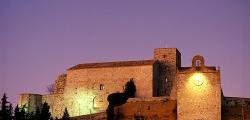
VERUCCHIO
Verucchio, that was the centre of the Villanovan civilization, is idyllically set just in the heart of a privileged panoramic area that overlooks both the valley of the river Marecchia and the sea. Its history is strictly interwoven with the glorious vicissitudes experienced by the members of the Malatesta Family, who settled in Romagna in the XII century and brought prosperity to the whole surrounding area. The old town cherishes outstanding monuments and buildings dating back to that age, such as the impressive Malatesta Fortress or “Rocca del Sasso” (Stone Fortress), the civic tower and the imposing city walls. Walking down the streets of the city centre, tourists won't miss the opportunity to visit the city's important Archaeological Civic Museum.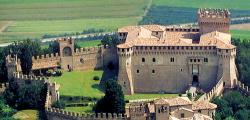
GRADARA
Idyllically set halfway between the Marches and Romagna, the picturesque village of Gradara still retains its impressive medieval fortress, imposing city walls and charming buildings. The city's fascinating history is strictly interwoven with a legendary episode that is said to have taken place inside the city's fortress and was even celebrated by Dante in his Divine Comedy. The protagonists are Paolo Malatesta and Francesca da Polenta, whose tragic love story inspired some of Dante's most famous verses:“Amor, ch'a nullo amato amar perdona” (Love that exempts no one loved from loving in return). Gradara is the privileged destination for those interested in going over their vicissitudes while discovering our past history.
BOOK YOUR HOTEL